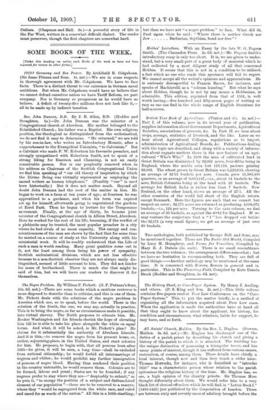British Year Book of Agriculture. (Vinton and Co. 5s. net.) —
Part L of this volume, now in its second year of publication, supplies information about Government Departments, Agricultural Societies, associations of growers, &c. In Part IL we hear about crops, acreage, statistics of livestock, and the like. Later on we hear about Agricultural Colleges, regulations as to import, administration of Agricultural Boards, &c. Publications dealing with the topic are described, and along with a variety of informa- tion about cognate matters there is the new feature of an agri- cultural " Who's Who." In 1908 the area of cultivated Land in Great Britain was diminished by 32,061 acres, four-fifths being in England, where the arable area lost 118,118, pasture gaining 93,062. The wheat grown in Great Britain was 6,223,639, showing an average of 32.15 bushels per acre. Canada grew 11,586,403 quarters, or an average of 6,610,147,—i.e., about 14 bushels to the acre, British Columbia being at the head with 23 bushels. The average for British India is rather less than 7 bushels. New Zealand, on the other hand, shows an average of 27.5. All the other countries of the world fall short of the English return except Denmark. Here the figures are such that we cannot but suspect an error; 32,171 acres are returned as producing 4,034,672 bushels,—i.e., 12i per acre. Turning to the oats column, we find an average of 35 bushels, as against the 4082 for England. If we may venture the conjecture that a " 1 " has dropped out befOre the 32,171 (a very small figure), we get an average of just over 30 bushels.














































 Previous page
Previous page